03《物流专业英语》--Unit-3-Supply-chain-concept--第三版新编
专业英语物流与供应链管理ppt课件
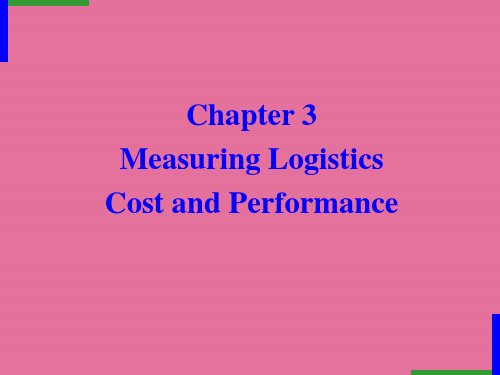
Profit Sales
(Margin)
无差别曲线 indifference curve
Sales
Capital employed
(Asset turn)
20% ROI 15% ROI 10% ROI
无差别曲线是用来表示两种商品的不同数量 的组合给消费者所带来的成效完全一样的 一条曲线。 无差别曲线具有四个重要特征:第一,无 差别曲线是一条向右下方倾斜的曲线,其 斜率为负值。第二,在同一平面图上可以 有无数条无差别曲线。第三,在同一平面 图上,恣意两条无差别曲线不能相交。第 四,无差别曲线是一条凸向原点的线。
指出总本钱分析的根本原理,以物流为导向 的系统的本钱核算体系及其合理运作应具备 的条件。
This chapter
Outlines the many ways in which logistics management can impact on overall return on investment and ultimately, shareholder value.
核算体系该当根据不同客户种 类、不同细分市场、不同配送 渠道进展单独的本钱与收益分 析。
How to operate the principles
To operationalize these principles requires an ‘output’ orientation to costing.
Highlights the need to identify the cost drivers in the logistics pipeline and to replace traditional forms of cost allocation with more appropriate methods.
物流专业英语Chapter III
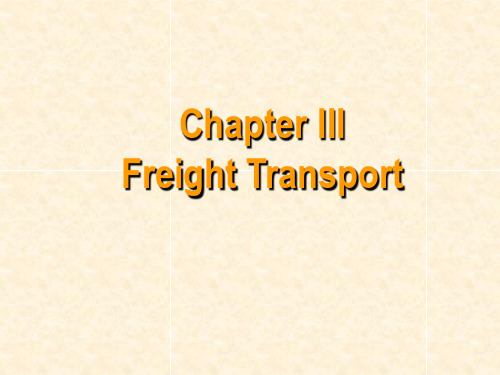
the course of full container load
the course of less container load
Inter-modal transportation Containers
the advantage container
Outline-3
Part III Supplementary Reading
Transport Participants
Shipper and consignee Carrier agents Government
Chapter III Freight Transport
Outline-1
Part I Function and Modes of Transportation Introduction to transportation Functions of transportation
Product movement Product storage
Internet
Public
•Part I Function and Modes of Transportation Introduction
Transportation is one of the most significant areas of logistics management because of its impact on customer service levels and the firm‟s cost structure. Transportation refers to the physical movement of goods from a point of origin to a point of consumption and can involve raw materials being brought into the production process/or finished goods being shipped out to the customer. Transportation is a very visible element of logistics. Consumers are accustomed to seeing trucks and trains transporting product or parked at business facilities. Few consumers fully understand just how dependent our economic system is upon economical and dependable transportation.
物流专业英语参考答案

ReferencesUnit 1 An Introduction to Business LogisticsPart II. Exercises for Dialogue 1Answer the following questions according to the dialogue.1.Logistics means to supply the right product at the right time in theright quantity in the right condition at the right place for the right customer at the right price.2.It includes the procurement, maintainance, distribution andreplacement of personnel and material.3.These two concepts are the same meanings. Logistics is generalmeaning and includes military definition and business definition.Business logistics stresses special term on a trade or business. Exercises for Dialogue 21.(Opening)2.(Opening)Part III. Practical ReadingsExercises for Text 1I. Answer the following questions:1. Business logistics means to be defined as a business-planning framework for the management of material, service, information and capital flows.2. Business logistics involves the following activities: demand forecasting,procurement, materials handling, packaging, warehouse and inventory management, ordering processing, logistics communications, transport, customer service and so on.3. The role of logistics is to maintain the balance between the minute details and the main elements involved in a product.II.1.商务物流管理有不同版本的不同定义 2 必要资源的利用3. 逆向货物的搬运4. 人员和材料的补充5. 复杂信息6. 现代的商业环境7. 需求预测8. 设施场地选择9. 公司最重要的财富10. 公司战略抉择走势评定III. definitions—heart---output---service---strategyIV. 1. 这一非常宽广的物流观点把单一的供应链与贸易公司的方方面面整合在一起。
物流专业英语

物流专业英语 十
• • • • • • • • 1. raw materials 原材料; 2. finished goods 成品; 3. production cost 生产成本; 4. product cost 产品成本; 九 5. aggregate product cost 产品总成本; 6. logistic activity 物流活动; 7. railway 铁路; 8. highway 高速公路.
物流专业英语 十一
• • • • • • • • 1. port of unloading 卸货港 2. port of loading 装运港 3. container 集装箱 九 4. FOB 离岸价 5. CFR 到岸价(无保险) 6. CIF 到岸价(含保险) 7. the time of shipment 装运时间,船期 8. shipping space 仓位
物流专业英语 十二
• • • • • • • • 1. FCL 整箱货,整柜装箱装载 2. LCL 拼箱货,散货拼箱 装载 3. TEUs 20英尺标准箱 4. FEUs 40英尺标准箱 九 5. international freight forwarder 国际代运公司 6. customs 海关 7. forwarder 货代(货运代理) 8. shipping agent 船运代理人
物流专业英语 九
• • • • • • • 1. motor transportation 汽车运输; 2. rail transportation 铁路运输; 3. air transportation 航空运输; 4. water transportation水路运输; 5. pipeline transportation 管道运输; 6. point-of-origin 原产地(origin place); 7. point-of-consumption 消费地点(place of consumption); • 8. logistician• • • • • • • • 1. logistics 物流 2. article 物品 3. goods 商品 4. cargo 货物,船货 5. logistics activy 物流活动 6. logistics cost 物流成本 7. logistics management 物流管理 8. supply logistics 供应物流
{物流管理}物流专业英语中英文
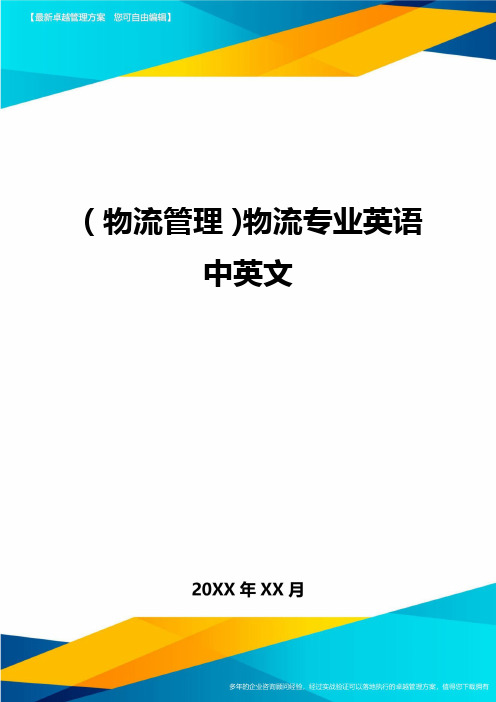
(物流管理)物流专业英语中英文⏹Highlightstheprinciplesofcompetitivestrategyandthepursuitofdifferentiationthroughthedevelopmentofproductivityandvalueadvantage.⏹强调竞争策略的原则,说明应通过发展生产力和价值优势来追求产品差异化。
The definition of Logistics management(物流管理定义)⏹Logisticsistheprocessofstrategicallymanagingtheprocurement,movementandstorageofmaterials,partsandfinishedinventory(andtherelatedinform ationflows)throughtheorganizationanditsmarketingchannelsinsuchaway thatcurrentandfutureprofitabilityaremaximizedthroughthecost-effective fulfillmentoforders.物流是壹个过程,它对企业及其所有营销渠道,从战略的角度管理原材料、零部件和最终库存品(包括关联信息流)的采购、流通和存储,以低成本完成订单,从而实现当前和未来的收益最大化What’s the basic successful factors in the marketplace? (成功三要素)⏹itisthe“ThreeC’S”:⏹TheCompany⏹It’sCustomers⏹It’sCompetitorsWhat’s the source of competitive advantage?(竞争优势)Thesourceofcompetitiveadvantageisfoundfirstlyintheabilityoftheorganizationt odifferentiateitself,intheeyesofthecustomers,fromitscompetitionandsecondlybyoperatingatalowercostandhenceatgreaterprofit.竞争优势首先源于企业标新立异的能力,企业只有自身和众不同,才能于客户眼中脱颖而出;其次,竞争优势源于比竞争对手更低的运营成本及因此获得的高利润。
物流专业英语pdf
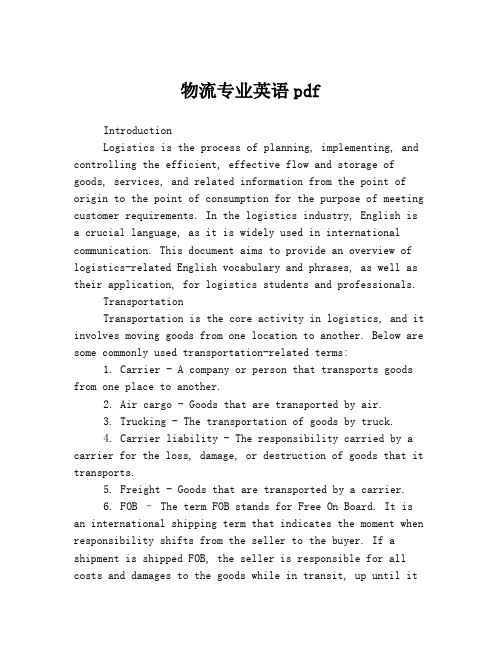
物流专业英语pdfIntroductionLogistics is the process of planning, implementing, and controlling the efficient, effective flow and storage of goods, services, and related information from the point of origin to the point of consumption for the purpose of meeting customer requirements. In the logistics industry, English is a crucial language, as it is widely used in international communication. This document aims to provide an overview of logistics-related English vocabulary and phrases, as well as their application, for logistics students and professionals.TransportationTransportation is the core activity in logistics, and it involves moving goods from one location to another. Below are some commonly used transportation-related terms:1. Carrier - A company or person that transports goods from one place to another.2. Air cargo - Goods that are transported by air.3. Trucking - The transportation of goods by truck.4. Carrier liability - The responsibility carried by a carrier for the loss, damage, or destruction of goods that it transports.5. Freight - Goods that are transported by a carrier.6. FOB – The term FOB stands for Free On Board. It is an international shipping term that indicates the moment when responsibility shifts from the seller to the buyer. If a shipment is shipped FOB, the seller is responsible for all costs and damages to the goods while in transit, up until itis loaded onto the shipping vessel.WarehousingWarehousing is the process of storing goods before they are transported to their final destination. Here are some common warehousing-related terms:1. Inventory - A list of items that a business owns and plans to sell.2. Receiving - The process of accepting goods into a warehouse.3. Picking - The process of selecting goods from a warehouse to fulfill an order.4. Loading - The process of placing goods on a vehiclefor transportation.5. Stock keeping unit (SKU) - A unique code used to identify a specific item in a warehouse.6. Cycle counting - The process of counting a small portion of a warehouse's inventory on a regular basis to ensure accuracy.Supply ChainThe supply chain is the network of businesses and individuals that are involved in the creation and delivery of a product or service. Here are some common supply chain-related terms:1. Bill of lading - A legal document that details the goods being transported and the terms of their transportation.2. Just-in-time (JIT) - A supply chain philosophy that emphasizes the delivery of products at the exact moment they are needed.3. Procurement - The process of acquiring goods or services from external sources.4. Lead time - The amount of time it takes to complete aprocess from start to finish.5. Vendor managed inventory (VMI) - A process where the vendor manages their customer's inventory levels to ensure that their customers always have what they need.ConclusionUnderstanding logistics-related English vocabulary and phrases is vital for effective communication in the logistics industry. This document provides an overview of some of the most commonly used logistics-related terms in transportation, warehousing, and the supply chain. By using this document as a reference guide, logistics students and professionals can increase their knowledge of logistics terminology, which can aid them in their day-to-day activities.。
《物流与供应链管理》读书笔记英文版

《物流与供应链管理》(LOGISTICS AND SUPPLY CHAIN MANAGEMENT)Capsule summary of the book:The world changes unpredictably, which is dependent on the quick transformation of supply chain to adapt to the variational circumstances. This book focuses tightly on those variations mentioned above, emphasizing the problems that appear whenenterprises attach importance to complicated management, as well as whenforecast-driven business modeltransforms into demand-driven business model. Also, this book elaborates how to gives enterprises dominating and competitivesuperiority with effectivelogistics and supply chain management.Chapter1 Logistics, the supply chainand competitive strategy1.1Supply chain management is a wider concept than logisticsOne goal of supply chain managementmight be to reduce or eliminate the buffers of inventory that existbetween organizations in a chain through the sharing of information ondemand and current stock levels. This is the concept of ‘Co-ManagedInventory’ (CMI).The focus of supply chain management is upon the managementof relationships in order toachieve a more profitable outcome for allparties in the chain. This brings with it some significantchallengessince there may be occasions when the narrow self-interest of one partyhas to be subsumed for the benefit of the chain as a whole.1.2Competitive advantageAt itsmost elemental, commercial success derives from either a cost advantageor a value advantage or, ideally, both. It is as simple as that – themost profitable competitor in any industry sector tends to be the lowestcost producer or the supplier providing a product with the greatestperceiveddifferentiated values.A useful way of examining the available options is topresent them as a simple matrix.Value advantageCost advantageTo summarize, those organizations that will be the leaders in the marketsof the future will be those that have sought and achieved the twinpeaks of excellence: they have gained both cost leadership and serviceleadership.1.3 The supply chain becomes the value chainOrganizations shouldlook at each activity in their value chain and assess whether they have a real competitive advantage in the activity. If they do not, the argumentgoes, then perhapstheyshould consider outsourcing that activity to apartner who can provide that cost or value advantage.1.4The mission of logistics managementThe scope oflogistics spans the organization, fromthe management of raw materials through to the delivery of the finalproduct.The last decade has seen the rapid introduction of flexiblemanufacturing systems (FMS), of new approaches to inventory based onmaterials requirements planning (MRP) and just-in-time (JIT) methodsand, perhaps most important of all, a sustained emphasis on total qualitymanagement (TQM).1.5 The changing competitive environment●The new rules of competition●Globalization of industry●Downward pressure on price●Customers taking controlSummary:This chapter familiarizes the reader with the tenets of competitive strategyand within them the vectors of strategic direction: cost and valueadvantage.Vertically integrated businesses continue to be dismembered, refocusedand transformed into virtual ones held together not by ownership but by closely integrated core business processes and financial engineering.Instead of rivalry and mistrust within the supply chain, newcompetitive pressures are demanding speed and flexibility, which themselvesrequire greater openness and trust. In fact the ability to manageprocess innovation and integration are becoming as important capabilitiesas product innovation.Chapter2T Logistics and customervalue2.1 Delivering customer valueQuality × ServiceCustomer value = ––––––––––––––––Cost × TimeQuality: The functionality, performance and technical specificationof the offer.Service: The availability, support and commitment provided to thecustomer.Cost: The customer’s transaction costs including price and lifecycle costs.Time: The time taken to respond to customer requirements, e.g.delivery lead times.2.2 What is customer service?Customer service could be examinedunder three headings:1. Pre-transaction elementsWritten statements of service policy, Accessibility, Organization structure, System flexibility.2. Transaction elementsOrder cycle time, Inventory availability, Order fill rate, Order status information.3. Post-transaction elementsAvailability of spares, Call-out time, Product tracing/warranty, Customer complaints, claims, etc.2.3 The impact of out-of-stockIn the circumstance of out-of-stock, generally,31%Substitute same brand15%Delay purchase19%Substitute different brand26%Buy item at another store9%Do not purchase itemThe impact of logistics and customer service on marketingConsumerfranchise * Customerfranchise * Supply chainefficiency = Marketingeffectiveness•Brand values•Corporate image•Availability•Customer service•Partnership•Quick response•Flexibility•Reduced asset base•Low–cost supplier•Market share•Customer retention•Superior ROI2.4 Customer service and customer retentionThe importance of customer retention is underlined by the conceptof the ‘lifetime value’ of acustomer. The lifetime value of a customer iscalculated as follows:Lifetime value = Average transaction value× Yearly frequencyof purchase× Customer ‘lifeexpectancy’A prime objective of any customer service strategy should be to enhancecustomer retention.2.5Market-driven supply chainsNow, instead ofdesigning supply chains from the ‘factory outwards’ the challenge is todesign them from the ‘customer backwards’his new perspective sees the consumer not at the end of the supplychain but at its start. In effect this is the philosophical differencebetween supply chain management and what more properly might becalled ‘demand chain management’.1.IdentifyvaluesegmentsWhat do our customers value?2.Define thevaluepropositionHow do we translate theserequirements into an offer?3.Identifythe marketwinnersWhat does it take to succeedin this market?4.Develop thesupply chainstrategyHow do we deliver againstthis proposition?2.6Defining customer service objectivesThe whole purpose of supply chain management and logistics is to provide customers with the level and quality of service that they requireand to do so at less cost to the total supply chain. The perfect order is achievedwhen the customer’s service requirements are met in full.To calculate the actual service level usingthe perfect order concept requires performance on each element to bemonitored and then the percentage achievement on each element to bemultipliedtogether.2.7Setting customer service prioritiesQuadrant 1: Seek cost reductions2: Provide high availability3: Review4: Centralized inventory2.8Setting service standardssome of the key areaswhere standards are essential:Order cycle time Stock availability Order-size constraints Ordering convenience Frequency of delivery Delivery reliability Documentation quality Claims procedure Order completeness Technical support Order status informationthe following measures provide valuable indicators of performance:Pre-transactionStock availabilityTarget delivery dates Response times to queriesTransactionOrder fill rateOn-time deliverBack orders by ageShipment delaysProduct substitutionsPost-transactionFirst call fix rateCustomer complaintsReturns/claimsInvoice errorsService parts availabilitySummary:Ultimately all businesses compete through seeking to deliver superiorcustomer value and logistics processes provide the means by which customerservice is delivered.Logistics management can play a key role in enhancing customerlifetime value through increasing customer satisfaction and enhancedcustomer retention. To achieve this will require the development of amarket-driven logistics strategy and the redefinition of service objectivesbased upon customers’ specific requirements. ‘Perfect order’achievement should form the basis for the measurement of service performanceand the creation of service standard.Chapter3 Measuring logistics costs and performance3.1Logistics and the bottom lineProfitProfitSalesROI = ––––––––––––––––This ratio can be further expanded:ROI = –––––– × –––––––––––CapitalemployedSales Capital employedIt will be seen that ROI is the product of two ratios: the first,profit/sales, being commonly referred to as the margin and the second,sales/capital employed, termed capital turnover or asset turn. Thus togain improvement on ROI one or other, or both, of these ratios mustincrease. Typically many companies will focus their main attention onthe margin in their attempt to driveup ROI, yet it can often be moreeffective to use the leverage of improved capital turnover to boost ROI.3.2 Customer profitability analysisBuildDanger zoneCost engineerProtectChapter4 Creating the responsive supply chain4.1Product ‘push’ versus demand ‘pull’whilst independent demand may be forecast using traditional methods,dependent demand must be calculated, based upon the demand at thenext level in the logistics chain.4.2 The foundations of agilityBusiness process re-engineering (BPR) is the term frequently appliedto the activity of simplifying and reshaping the organizational processeswith the goal of achieving the desired outcomes in shorter time-framesat less cost. Many processes in the supply chain are lengthy because theconstituent activities are performed in ‘series’, i.e. in a linear, ‘one afterthe other’ way. It is often possible to re-engineer t he process so thatthose same activities can be performed ‘in parallel’, i.e. simultaneously.Postponement refers to the process by which the commitment of a productto its final form or location is delayed for as long as possible. Whendecisions on the final configuration or pack have to be made ahead ofdemand there is the inevitable risk that the products that are availableare not the ones the customer wants.The philosophy of postponement ideally would begin on the drawingboard so that products are designe d with late configuration inmind. The longer that products can remain as generic ‘work in progress’ then the more flexibility there will be to ensure the ‘rightproduct in the right place at the right time’.Chapter5 Strategic lead-time management5.1 The concept of lead timeFrom the customer’s viewpoint there is only one lead time: the elapsedtime from order to delivery. Clearly this is a crucial competitive variableas more and more markets become increasingly time competitive.Nevertheless it represents only a partial view of lead time. Just as important, from the supplier’s perspective, is the time it takes to convertan order into cash and, indeed, the total time that working capitalis committed from when materials are first procured through to whenth e customer’s payment is received.5.2 Logistics pipeline managementThe goals of logistics pipeline management are:●Lower costs●Higher quality●More flexibility●Faster response timesAn indicator of the efficiency of a supply chain is given by itsthroughput efficiency, which can be measured as:Value-addedtime*100End-to-end pipeline timeThroughput efficiency can be as low as 10 per cent, meaning that mosttime spent in a supply chain is non-value-adding time.5.3 The lead-time gapReducing logistics lead timeBottleneck managementImproving visibility of demandSummary:Time compression in the pipeline has the potential both to speed upresponse times and to reduce supply chain cost. The key to achievingthese dual goals is through focusing on the reduction of non-value-addingtime –and particularly time spent as inventory. Whereas in the past logisticssystems were very dependent upon a forecast, with all the problemsthat entailed, now the focal point has become lead-time reduction.Chapter6 The synchronous supply chain6.1 The role of information in the virtual supply chainFunctions of a logistics information system:Planning functionCo-ordination functionDatabaseCustomer servicecommunication functionControl function6.2 Implications for logisticsThe basic principle of synchronization is to ensure that all elements ofthe chain act as one and hence there must be early identification ofshipping and replenishment requirements and, most importantly of all,there must be the highest level of planning discipline.In a synchronous supply chain the management of in-bound materialsflow becomes a crucial issue.The idea of ‘stockless distribution centres’ or ‘cross-docking’enables a more frequent and efficient replenishment of product frommanufacture to individual stores.6.3 ‘Quick response’ logisticsWhat has made QR possible is thedevelopment of information technologyand in particular the rise ofInternet-enabled data exchange, bar coding, the use of electronic pointof sale (EPOS) systems with laser scanners and so on.Quick responseLess inventoryrequiredReducedlead timesLesspipelineinventoryLesssafety stockReducedforecastingerrorSummary:The key to supply chain responsiveness is synchronization.Synchronization implies that each entity in the network is closely connectedto the others and that they share the same information. In thepast there was often limited visibility, either upstream or downstream,meaning that organizations were forced to act independently, makingtheir own forecasts, and, as a result, i nevitably relying upon a ‘push’rather than a ‘pull’ philosophy.Chapter7 Managing the global pipeline7.1 The trend towards globalization in the supply chainFocused factoriesCentralization of inventoriesPostponement and localization7.2 Gaining visibility in the global pipelineSupply chain event management (SCEM) is the term given to theprocess of monitoring the planned sequence of activities along a supplychain and the subsequent reporting of any divergence from that plan.Ideally SCEM will also enable a proactive, even automatic, response to deviations from the plan.Chapter8 Managing risk in thesupply chain8.1 Why are supply chains more vulnerable?A focus on efficiency rather than effectivenessThe globalization of supply chainsFocused factories and centralized distributionThe trend to outsourcingReduction of the supplier base8.2 Understanding the supply chain risk profileSupply chain risk = Probability of disruption × ImpactThis audit shouldexamine potential risk to business disruptions arising from five sources: Supply riskDemand riskProcess riskControl riskEnvironmental risk8.3 Managing supply chain risk1.Understand the supply chain2.Improve the supply chain3.Identify the critical paths (nodes and links)4.Manage the critical paths5.Improve network visibility6.Establish a supply chain continuity team7.Work with suppliers and customers to improvesupply chain risk management proceduresSummary:All the evidence indicates that as markets become more volatile and thebusiness environment more turbulent, so supply chains become more vulnerableto disruption. Not all of the risk to supply chain continuity isexternal. Significant risk can be created as a result of management decisionsthat are taken on supply chain design and strategy.Chapter9 Overcoming the barriers tosupply chain integration9.1 Creating the logistics visionIdeally the logistics vision should be built around the simple issue of‘How do we intend to use logistics and supply chain management tocreate value for our customers?’The four elements of logistics-derived customer value highlightedpreviously are ‘Better, Faster, Cheaper, Closer’ and the criterion for agood logistics vision s tatement is that it should provide the roadmapfor how these four goals are to be achieved.9.2 Developing the logistics organizationThe horizontal organization has a number of distinguishing characteristics.It is:Organized around processesFlat and de-layeredBuilt upon multi-functional teamsGuided by performance metrics that are market-based9.3 BenchmarkingCompetitive benchmarking might simply be defined as the continuousmeasurement of the company’s products, services, processes andpractices against the standards of best competitors and other companieswho are recognized as leaders. The measures that are chosen forthe comparison must directly or indirectly impact upon customers’evaluation of the company’s performance.Identifying logistics performance indicatorsThe idea behind the balanced scorecard is thatthere are a number of key performance indicators –most of them probablynon-financial measures –that will provide management with abetter means of meeting strategic goals than the more traditional financiallyoriented measures.Step 1: Articulate logistics and supply chain strategy2: What are the measurable outcomes of success?3: What are the processes that impact these outcomes?4: What are the drivers of performance within these processes?In this framework the four key outcomes of success are suggested to be:Better, Faster, Cheaper, CloserSummary:internally integrated across functions and they are externally integratedwith upstream suppliers and downstream customers. Many companiesare impeded in their attempts to become more agile and responsivebecause of an entrenched functional structure. They manage functionsrather than processes and hence have a fragmented approach to themarketplace. It is also difficult for such firms to contemplate externalintegration when they lack internal integration.Chapter10Entering the era ofnetwork competition10.1 Seven major business transformationsFrom supplier-centric to customer-centricFrom push to pullFrom inventory to informationFrom transactions to relationshipsFrom ‘trucks and sheds’ to ‘end-to-end’ pipeline managementFrom functions to processesFrom stand-alone competition to network rivalry10.2 From 3PL to 4PL™Third-party logistics service providers are companies who provide arange of logistics activities for their clients. They might operate distributioncentres, manage the delivery of the product through theirtransport fleets or undertake value-adding services such as re-packing.The fourth-party logistics service provider was that because modern supply networksare increasingly global and certainly more complex, the capabilities tomanage the network probably do not exist in any one organization. Insuch situations, there is a need for an organization who can use itsknowledge of supply chains and specialist third-party service providersto manage and integrate the complete end-to-end supply chain.The 4PL™ would assemble a coalition of the ‘best of breed’ serviceproviders and – using its own information systems capability – ensure acost-effective and sustainable supply chain solution.Whether the 4PL™ be a joint venture or some other model there arefour key components that must be in place. These are:1. Systems architecture and integration skills2. A supply chain ‘control room’3. Ability to capture and utilize information and knowledge across the network4. Access to ‘best of breed’asset providers。
(完整word版)《物流专业英语》课程教学大纲
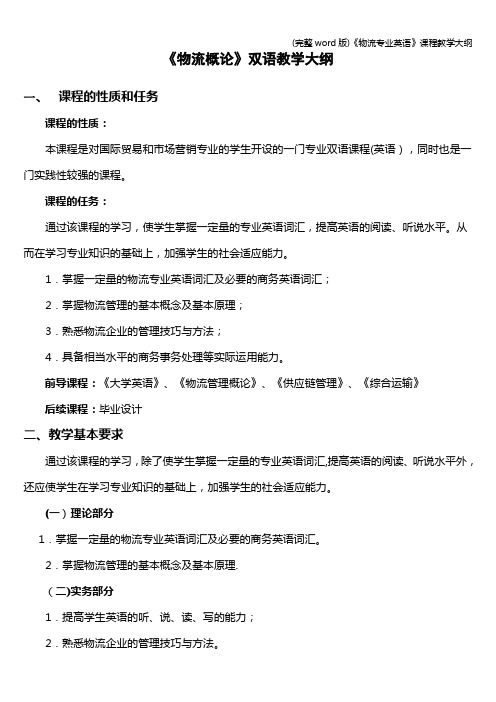
《物流概论》双语教学大纲一、课程的性质和任务课程的性质:本课程是对国际贸易和市场营销专业的学生开设的一门专业双语课程(英语),同时也是一门实践性较强的课程。
课程的任务:通过该课程的学习,使学生掌握一定量的专业英语词汇,提高英语的阅读、听说水平。
从而在学习专业知识的基础上,加强学生的社会适应能力。
1.掌握一定量的物流专业英语词汇及必要的商务英语词汇;2.掌握物流管理的基本概念及基本原理;3.熟悉物流企业的管理技巧与方法;4.具备相当水平的商务事务处理等实际运用能力。
前导课程:《大学英语》、《物流管理概论》、《供应链管理》、《综合运输》后续课程:毕业设计二、教学基本要求通过该课程的学习,除了使学生掌握一定量的专业英语词汇,提高英语的阅读、听说水平外,还应使学生在学习专业知识的基础上,加强学生的社会适应能力。
(一)理论部分1.掌握一定量的物流专业英语词汇及必要的商务英语词汇。
2.掌握物流管理的基本概念及基本原理.(二)实务部分1.提高学生英语的听、说、读、写的能力;2.熟悉物流企业的管理技巧与方法。
3.具备相当水平的商务事务处理等实际运用能力。
三、教学条件1.课堂教学时,需使用多媒体教学设备,易于学生掌握所学知识。
四、教学内容及学时安排三、课程教学内容Chapter 1 Logistics主要讲授:the introduction of logistics,what’s logistics,evolution of the logistics management concept, components of a logistics system, five key issues for logistics effectiveness重点:the introduction of logistics,what's logistics,evolution of the logistics management concept,components of a logistics system, five key issues for logistics effectiveness难点:five key issues for logistics effectivenessChapter 2 Supply Chain Management主要讲授:Role of Logistics in the Supply Chain,What is Supply Chain Management?重点:Developing a Supply Chain,The Possibility of Creating a Supply Chain,难点:How to set up a supply chain management.Chapter 3 Transportation主要讲授:transportation facility , the transportation modes(rail network ,motor carriers,water transport ,pipelines,air transport) ,transportation management 重点:transportation facility ,the transportation modes,transportation management难点:water transport,the economic factors of transportationChapter 4 A Third Party Logistics Provider主要讲授:What is Outsourcing?, Definition of Third Party Logistics重点:Searching the 3PL Companies,Evaluating 3PL companies难点:How to Select a Third Party Logistics ProviderChapter 5 Retailing Logistics主要讲授:Retail Supply Chains,Retailing Logistics in UK重点:The Retail Logistics Landscape Is so Diverse, We Are Totaly Convinced about the Potential of RFID难点:How to understand retail supply chainChapter 6 Chain Store主要讲授:Standardization of the Operation of Chain Stores Opinion, The Definition of Chain Stores重点:The conception about chain stores难点:How to understand a chain storeChapter 7 Distribution Center主要讲授:distribution center, the ABC catering services ltd。
物流英语Unit 3
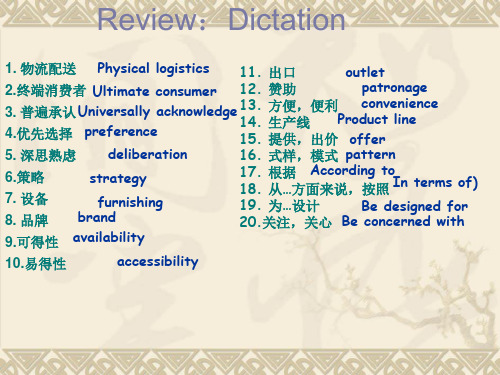
第三单元 运输 UNIT3 Transportation
ⅠWords 9. carrier(运货的)船、承运人 10. middleman中间人 11. freight forwarder货运代理 12. broker经纪人 13. zero inventory零库存 14. variable costs可变成本 15. transport rates运费费率 16. pricing 定价
三、语法:被动语态 被动语态是由be+过去分词构成的,be随时态的变化而变化.
第三单元 运输 UNIT3 Transportation
ຫໍສະໝຸດ 被动语态形式有以下几种: 1 、一般现在时: am/is/are+done(过去分词) Eg: Visitors are requested not to touch the exhibits. 2 、现在完成时: has/have been done Eg: All the preparations for the task have been completed, and we’re ready to start. 3 、现在进行时: am/is/are being done Eg: A new cinema is being built here. 4 、一般过去时: was/were done Eg: I was given ten minutes to decide whether I should reject the offer. 5 、过去完成时: had been done Eg: By the end of last year, another new gymnasium had been completed in beijing.
物流英语unit 3

• 1.仓储在集成的物流战略以及建立和维持供 应链成员企业的良好关系中起着重要的作 用。仓储还会影响到客户服务水平及销售 和营销的成功。仓储是生产设施和消费者 ,或者说是供应商和生产工厂之间连接的 纽带。仓储通过整合厂内资源来支持生产 并在恰当的时间将物料配送到生产点。
Text 1 Warehouse Operation
Word Study
• Unequal:不规则的;不平等的;不胜任的 e.g.她的两只脚大小不一样。 • Her feet are of unequal size. e.g.他不胜任这项工作。 • He was unequal to the job. e.g.社会财富的分配是不平等的。 • The distribution of wealth of the society is unequal.
Terms Study
• • • • • • • • • • 11. fork lift truck 12.conveyor 13.Shelf life 14.Goods Stack 15.Receiving space 16. Tallying space 17.Order picking 18.Stock-out rate 19. replenishment 20. Safety stock / lead time
Text 1 Warehouse Operation
The public warehouse is essentially space that can be leased to solve short-term distribution needs. Using public warehouses offer more flexibility for the users since it require no capital investment on the user’s part.
《物流专业英语(第3版)》试题库 03_参考答案_模拟试题_2__物流专业英语(3)

1 / 7__________大学 2012~2013学年第____学期 《物流专业英语》模拟试卷 (二) 参考答案I. 术语翻译(本大题共30个小题,每小题0.5分,共15分) (一)英译汉部分 1)retail outlet 零售网点 2)production and distribution 生产及配送 3)raw materials 原材料 4)semi-finished goods 半成品 5)finished goods 成品 6)physical distribution 实物配送 7)recycling 回收(二)汉译英部分8) 线路预测route forecasts 9) 安全储备security reserves 10) 临时储存temporary storage 11) 再加工reprocessing 12) 散货流转bulk movements, 姓名学号班级 座位号 考试说明。
1、本试卷为闭卷考试 2、试卷中所有试题的答案均写在答题纸上 3、总分:100分,考试时间:120分钟13)多点流转multi-drop movement14)零担载货part loads15)多种零担载货multi-part loads.II.完成下列句子(本大题共15个小题,每小题1分,共15分)16)Transport is often place-oriented while distribution is _______________________ (面向客户的). (customer-oriented)17)In practice, the logistics distribution mode varies with operator,_______________________ (产品的性质), location, and other factors. (nature of product)18)Even the same DC may simultaneously adopt _______________________(若干有区别的配送模式)as per the specific situations. (a number of differentiated distribution modes)19)The term ‘movement’ refers to the _______________________(规划、监督和控制)of the movement of goods and people. (planning, monitoring and controlling)20)Such movements exist through all the stages of the journey_______________________(在起点和最终目的地之间), including any interchange, documentation processing, temporary accommodation and the procurement of the means of transport. (between origin and ultimate destination)21)This will save time and money, make the operation more profitable, and help_______________________(最小化任何潜在的有害影响)on the environment.(minimize any potentially harmful effects)22)_______________________(集中控制)means that sufficient information is availablefor the right decisions to be made promptly and the resources are available for carrying out the decisions. (Centralized control)23)In order to do this, the operator has to keep traffic moving without unnecessary checksand _______________________(避免堵塞)at bottlenecks, transfer points and terminals. (avoid congestion)24)Failure to maintain an even flow will result in _______________________(延长行车时间)and turn-round and inefficient use of transport resources. (extended journey times)25)Maximum utilization is achieved by a series of techniques: such as loading a unit oftransport _______________________(达到其最大允许容量). (to its maximum permissible capacity)26)All of this must be consistent with the requirements of safety, adequate crew rest,2/ 7_______________________(遵守速度和载货规定)and fuel efficiency. (compliance with speed and load regulations)27)This unit deals with three such categories: bulk movements,_______________________(多点式运输)and multi-part loads. (multi-drop movement)28)Typically bulk movements are of _______________________(低价值商品)which canbe moved at low cost, usually with no great urgency. ( low-value commodities)29)The exceptions include road delivery of_______________________(专业燃油)andraw materials, for example heating oils and food ingredients. (specialist fuels)30)Such bulk commodities can be dangerous goods, and therefore require_______________________(搬运方面的专门技术). (expertise in handling)III.用动词的适当形式填空(本大题共10个小题,每小题1分,共10分)31)As with rail and air transport, large sums of money have to __________(spend) onmaintenance and control of traffic through the seaway. (be spent)32)These costs have to __________(add) to the operator’s own high costs. (be added)33)Sea transport __________(outdo) other forms of transport in terms of safety andcost-efficiency. (outdoes)34)Smaller non-urgent goods can __________(put) into containers for shipping in bulk.(be put)35)Costing is the process of __________(analyze) the costs and benefits of differentoptions. (analyzing)36)Costing is often __________ (refer) to as ‘cost-benefit analysis (CBA)’. (referred)37)The prime purpose of costing is to show the total cost of the service__________(render), and to analyze the composition of that cost. (rendered)38)The managers want to know how much it costs to __________(transport) a singlepassenger on the basis of per mile of travel.(transport)39)Indirect costs are costs __________(incur) incurred when running a business, ieadvertising, telephones, office staff salaries, heat and light, insurance on products, etc.(incurred)40)Fixed costs may __________ (not affect) by mileage or vehicle activity. (not beaffected)IV.概念解释(本大题共10个小题,每小题2分,共20分)3/ 741)What is VMI?VMI (Vendor Managed Inventory) is a means of optimizing Supply Chain performance in which the manufacturer is responsible for maintaining the distributor’s inventory levels. The manufacturer has access to the distributor’s inventory data and is responsible for generating purchase orders.42)What is bonded logistics?Bonded logistics refers to a range of special operations often conducted in a warehouse or other secured area in which dutiable goods may be stored, manipulated, or undergo manufacturing operations without payment of duty. It may be managed by the state or by private enterprise.43)What is JIT?Just in Time or JIT method creates the movement of material into a specific location at the required time, i.e. just before the material is needed in the manufacturing process.44)What is green logistics?Green Logistics is a supply chain management strategy that reduces the environmental and energy footprint of freight distribution. It focuses on material handling, waste management, packaging and transport.45)What is a 4PL Provider? 什么是4PL?Fourth Party Logistics, or 4PL, is the shared sourcing in supply chain spanning activity with a client and select teaming partner, under the direction of a 4PL integrator.46)What is Integrated logistics support?Integrated logistics support (ILS) is an integrated and iterative process for developing material and a support strategy that optimizes functional support, leverages existing resources, and guides the system engineering process to lower life cycle cost and decrease the logistics footprint (demand for logistics), making the system easier to support.47)What is City Logistics?City Logistics is the process for totally optimizing the logistics and transport activities by private companies with the support of advanced information systems in urban areas considering the traffic environment, its congestion, safety and energy savings within the framework of a market economy.48)What is ICT?ICT, short for ‘information and communication technology’, is the use of electronic processing media for the collection, analysis and evaluation of data, and the transfer of information from one point to another.49)What is EDI? 什么是EDI?Electronic Data Interchange (EDI) refers to the structured transmission of data between4/ 7organizations by electronic means. It is used to transfer electronic documents from one computer system to another, i.e. from one trading partner to another trading partner. It is more than mere E-mail; for instance, organizations might replace bills of lading and even checks with appropriate EDI messages.50)What is e-business?E-business, or e-commerce, refers to the processing of business transactions via electronic means and with digitalized data.This data can be texts, images, sound, video or the combination thereof, which are transmitted over either open networks like the World Wide Web, or over closed networks like the Intranet and Extranet.V.英译汉(本大题共5个小题,每小题2分,共10分)51)Supply chain management has seen a large shift in recent years from the use ofin-house logistics operations to the use of third party logistics providers. 供应链管理近年来见证了从使用内部物流作业到使用第三方物流提供商的巨大转变。
03《物流专业英语》-PPT-Unit-3-Supply-chain-concept--第三版新编(1)
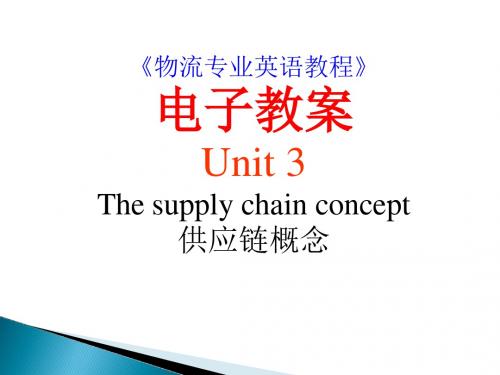
电子教案
Unit 3
The supply chain concept 供应链概念
授课日期 授课教师 授课专业/班级 讲授单元 单元讲授时长 讲授内容
_______年___月___日
______专业______班级 Unit 3 二学时 物流术语、课文、课堂练习
教学任务:
掌握本单元的物流专业术语 掌握本单元的核心概念 熟悉本单元的常用物流英语表达法 熟悉本单元的物流流程
What is a supply
chain?
什么是供应链?
“A supply chain is a network of
retailers, distributors, transporters, storage facilities, and suppliers that participate in the production, sale and delivery of a product to the consumer. The supply chain is typically made up of multiple companies who coordinate activities to set themselves apart from the competition.
Figure 2: A supply chain for passenger services 图2: 乘客服务的典型供应链
The supply chain strategy 供应链战略
While often applied to manufacturing and consumer products, a supply chain can also be used to show how several processes supply to one another. The supply chain definition in this sense can apply to Internet technology, finance, and many other industries.
物流英语复习

第一课:Supply Chain Management1.供应链定义:…..the integration of key business processes form end user through original suppliers that provides products , services , and information that add value for customers and other stakeholders.(P1)2.供应链的组成:SCM consist of a simplified supply chain network structure , the information and product flows , and the key supply chain business processes penetrating functional silos within the company and the various corporate silos across the supply chain.3.供应链成功战略:The successful supply chain strategies are listed listed as follows:①Market Saturation driven(市场浸透):Focusing on generating high profit margins through strong brands and ubiquitous marketing and distribution.②Operationally Agile(操纵敏捷性):Configuring assets and operations to react nimbly to emerging consumer trends along lines of product category or geographic region.③Freshness Oriented(新兴产品定位):Concentrating on earning a premium by providing the consumer with product that is fresher than competitive offerings④Consumer Customizer(客户管理):Using mass customization to build and maintain close relationships with end consumers through direct sales.⑤Logistics Optimizer(物流优化):Emphasizing a balance of supply chain efficiency and effectiveness⑥Trade Focused(集中交易):Prioritizing ” low price , best value ”for the consumer(as with the logistics optimizer strategy but focusing less on brand than on dedicated service to trade customers).4.物流定义:Logistics is that part of the supply chain process that plans , implements , and controls the efficient , effective flow and storage of goods , services , and related information form the point-of origin to the point-of-consumption in order to meet customers requirements.(P6)5.供应链结构组成:The SCM framework consists of three closely interrelated elements:the supply chain network structure、the supply chain business processes、the SCM components.(P8)第二课:Logistics Management1.物流的概念:is that part of the supply chain process that plans , implements and controls the efficient, effective flow and storage of goods , services and related information from the point of origin to the point of consumption in order to meet customers requirements.2.挑战满足客户需求四大条件:①The internet B2B Economy:a dramatic transformation in the use of the internet for business transactions between companies.②Reverse logistics(反向物流):the management of returned products to distributors, manufacturers or retails.③Real-time logistics Event Management(实时物流):the need for accurate and timely management of information in order to maintain on-time deliveries ,reduce inventory levels and ensure that the right product is the right place at the right time.④Technology solutions provide visibility: new logistics event management technologies to gain real-time visibility into logistics operations; ensure a more accurate, efficient and effective flow of goods; Reduce costs and increase customer satisfaction.第三课Ocean Shipping1.船舶类型Ship types:1. General cargo ship: 1) Conventional cargo ship{两用货船} 2)Multi-purpose general cargo ship {多用}3)Specialized dry cargo ship for the carriage of lumber{特殊干货船} 4)Refrigerator ship2. Container ship: 1)Cellular full container ship {隔栅式}2)Semi-container ship{半集装} 3)Roll on/Roll off container ship {滚装}4)Lift on/Lift off container ship {吊式}3. Lash-lighter aboard ship, also termed barge carrying vessel{载驳船}4. Tanker: 1)Oil tanker 2)Tanker for liquefied gas including petroleum gas and natural gas {液化气体船}3)Chemical tanker for the carriage of liquid chemical such as ammonia {化学品船}4)Miscellaneous tanker {各种其他形式船}5. Combined carrier: 1)Ore and oil carrier(O/O){矿-油两用船} 2)Ore and bulk carrier(O/B){矿-散} 3)Ore, bulk and oil carrier(O/O){矿-散货-油}2.海上运输类型:Type of ocean shipping service:1). Liners:①定义:Liners offer shipping space , as common carriers , on ships playing along fixed routes on regular schedule ,principally engaged in carrying general cargo in relatively small shipments and limited volumes .②特点:1)more calls along the route and a saving in time at port for loading and discharging, thus ensuring dispatch and delivery of shipments in good time2) feasibility of sending small installments of cargo instead of bulky shipments3) better technical equipment on board ship to ensure faster and safer sailing.2). Trampers :①定义:Trampers refers to ships playing on waterways without pre-set schedule or fixed routes and sailings normally depend on an availability of cargoes entrusted for carriages.②分类:time charter / voyage charter / demise charter* The Demise charter pay for: 1) Crew’s wages and provisions 2).Ship’s maintenance and stores3)Lubricating oil 4)Fresh water3.船舶证书Ship’s papers:I.主要重要证书包括:1.Certificate of Nationality 2.Certificate of seaworthiness 3.Certificate of Classification 4.Tonnage Certificate 5.Loadline Certificate 6.Rifrigerating Machinery Certificate 7.Wireless CertificateII.Certificate of Nationality: it is usual for the shipbuilder to issue a builder’s certificate giving detailed specifications of the shipIII.Certificate of Seaworthiness: it is imperative that a ship always maintains the technical standards and requirements for safe sailing at sea.IV.Certificate of Classification(船舶入籍证书): is an indication of the standard of a ship insofar as her structure , technical requirements and equipment are concerned , and since all necessary particulars are to be submitted to the organization concerned when classification of a ship is applied for ,an authentic record will be available of the state of the ship in question.V.Official Log Book(船员日志): An official log must be kept by every sea-going ship and the following matter must be record:1) A statement of conduct, character and the like of every member of the crew2) Every offence committed by a member of the crew, for which prosecution is intended3) Every conviction of a member of the crew and the punishment inflicted4) Every case of illness or injury or death happening to a member of the crew5) Every collision with any other ship and the circumstances leading themVI.Ship’s Articles (船员记录本) :give a description of crew and capacity in which each member serves, length of voyage ,amount of wages, ti me of commencement of voyage and scale of provisions.VII.Ship’s Log(航海日志):gives a daily record of the activities aboard a ship , either in port or in sailing . including loading and discharge of cargoes , weather conditions, position of ship when on voyage , time of departure and arrival of ship ,quantity of fuel and fresh water carried on board ,steps taken in the event of a casualty, etc.第七课Containerization1. Containerization : it is a system of intermodal cargo transport using standard containers that can be loaded on container ships, freight train wagons ,and trucks.2. Advantages of containerization:1).provide shipper with seagoing strong vans which not only protect shipments from damage and theft but also can be used repeatedly, thus reducing the expense of export packaging.2). containerized traffic is far more efficient than the traditional mode of transportation.3). containerized traffic comprise minimization of losses and simpler packaging.4). containerized traffic will contribute considerably to the substantial saving in the carrier’s overheads, thusrendering it possible for him to fix the fright rate at a more attractive level.3. Disadvantages1) The carriage of containers necessitates specific accommodations in the ship2) The manufacture or purchase of containers involves a considerable sum of money.3) To meet the specific requirements for container ships ,a special type of terminal different from traditionalberths is requires.4.Rules in containerization:Hague Rules(最多每个集装箱$100)Hague-Visby Rules (每单位10000 gold francs or 每公斤30 gold francs 取其高者)Hamburg Rules (每单位12500 gold francs or 每公斤37.5 gold francs 取其高者)第八课Warehousing and Storage1.Basic components of a warehouse: space, equipment ,and people.2.Warehouse functionglity:①consolidation集装: shipment consolidation is an economic benefit of warehouse. With this arrangement, the consolidating warehouse receives and consolidates materials from a number of manufacturing plants destined to a specific customer on a single transportation shipment.②Break bulk and cross-dock拆装、越库:warehouse operations are similar to consolidation except that no storage is performed.③Processing/postponement加工、延期: warehouse can also be used to postpone or delay, production by performing processing and light manufacturing activities.④Stockpiling 储存:the direct economic benefit of this warehouse service is secondary to the fact that seasonal storage is essential to select businesses.第九课Inventory Control1.库存概念:inventory control, otherwise known as stock control , is about how much inventory you have at any one time, and how you keep track of it.2.库存分类:(1). raw materials and components – ready to use in production;(2) .work in progress – inventory of unfinished goods;(3) .finished goods ready for sale;(4) .consumables –for example ,fuel and stationery.3.控制库存的方法:(1)minimum inventory level---you identify a minimum inventory level, and re-order when inventory reaches that level. This is known as the re-order level. (ROL)(2).inventory review(库存检查) ---you have regular reviews of inventory. At every review you place an orderto return inventory to a predetermined level.(3).just in time (JIT) --- this aims to reduce costs by cutting inventory to a minimum. Items are delivered whenthey are needed and used immediately. There is a risk of running out of inventory, so you need to be confident that your supplier can deliver.4.零库存或少库存优点:(1)efficient and flexible .you only have what you need when you need it. (2) .lower inventory and storage costs. (3).you can keep up-to-date and develop new products without wasting inventory.缺点:(1)meeting inventory needs can become complicated and expensive. (2).you might run out of inventory if there is a hitch in the system. (3).you are dependent on the efficiency of your suppliers.5.多库存优点:(1)easy to manage. (2).low management costs. (3). you never run out.缺点:(1)higher inventory, storage and insurance costs. (2).certain goods might perish. (3).inventory may become obsolete before it is used. (4).your capital is tied up.第十四课Bill of Lading1.提单的类型:(1)received for shipment bill of lading.(待装船)(2).shipped or on board bill of lading.(已装船)(3).straight bill of lading (记名).(4).blank bill of lading or open bill of lading(空白). (5).order bill of lading(指示). (6).clean bill of lading.(7)foul bill of lading.(不清洁)2.提单的三个作用:(1)it is a receipt for the goods;(2)it is a document of title ;and in certain cases.(3) It is a written evidence of the terms of the contract of affreightment..3.提单所写的项目:(1)name of shipper.(2)name of consignee.(3)the person or party to be notified at destination.(4)name of carrying vessel.(5)port of loading.(6).port of discharge.(7).place at which freight is to be paid or mode of payment.(8).particulars of cargo carried.(9).date and place of issue.(10).amount of freight and charges.(11).signature of master.In the bill of lading of the china ocean shipping company, china, there are the following statements on the face there of:(I).shipped on board the vessel named above in apparent good order and condition (unless otherwise indicated) the goods or packages specified herein are to be discharged at the above-mentioned port of discharge or as near thereto as the vessel may safely get and be always afloat.(II)The weight, measure, marks, numbers, quality, contents and value, being particulars furnished by the shippers, are not checked by the carrier on loading.Similar statements also appear in almost all bills of lading being used in shipping markets throughout the world.In the printed form of the bill of lading being used by china ocean shipping company, china, there are twenty-five clauses in all. There includes jurisdiction, period of responsibility, responsibilities, immunities, indemnity, deviation and so on.第15课Sea Protest1.定义:Sea protest:Sea protest is a document and sometimes just be called as the note of protest .2.什么时候发出该声明:The note of protest is a declaration by the master ,which gives full particulars of any heavy weather or other accident that may have cause damage to the ship or cargo with the extent unascertainable at the time when protest is noted.If the ship has encountered heavy weather or been involved in an accident on her voyage prior to arrive at the port , it is duty of the master to note sea protest at the first port of call within 24H of her arrival .The sea protest is required to protect the interests of the shipowner , and whenever there is any doubt that damage may have occurred as a result of heavy weather or other events , protest is noted by the master at the first port at which the ship calls .第16课General Average1.定义:A general average act can be established only where an extraordinary sacrifice or expenditure is voluntarily and reasonable made or incurred in time of peril for the purpose of preserving the property imperiled in the common adventure.2.基本特征essential feather of G.A.:(1) The common adventure must be in danger.(2)The sacrifice must be voluntary (intentional有意的)(3) The sacrifice or expenditure must be reasonably made or incurred.(4) The sacrifice or expenditure must be extraordinary in its nature and not one which is necessarily involvedand indispensable in performing the contract of carriage.(5) The object of the sacrifice or expenditure should only be the preservation of property endangered in thecommon adventure , not for the safety of either the ship or the cargo alone.(6) The loss must be the direct result or the reasonable consequence of a general average cargo.3.判定原则The principle of adjustment:That which is sacrificed for all is borne in proportion by all interested in the adventures .(All loss which arises in consequence of extraordinary sacrifices made , or expense incurred , for the preservation of ship and cargo comes within generalaverage , and must be borne proportionately by all who are interested .)4.共同海损牺牲:I.Jettison(抛弃)of cargo or ship’s materialsII.V oluntary stranding (自动搁浅)III.Refloating of ship (使再浮起)IV.Damage incurred in extinguishing fire(灭火)V.Ship’s materials and stores or cargo burnt for fuel5.共同海损费用:Port of refuge(避难)expenses 、Crew’s wages and maintenance , fuel and stores.、Discharge , reloading or handling of cargo, fuel and stores on board.、Substituted expenses替代费用(Temporary repairs暂时修理/ Towage拖船费/ Transshipment and forwarding. 转载)、Salvage chargers救援费、Sundries杂七杂八费用(Survey fees / Cables, telexes , trunk calls / Shipowner’s superintendent fees船东管理费/ G.A. disbursement insurance.保险费)6.共同海损分摊:①船:Sound market value at the time and place of termination of voyage, less the amount of loss or damagethrough causes other than general average ; or actual net value at the time and place of termination of voyage , plus the amount made good in general average.②货:CIF value ,less freight at the risk of the shipowner and the amount of loss or damage unconnected withgeneral average.③运费:Amount of freight at the risk of the shipowner ,less the expenses for earning it , such as port chargesand crew’s wages ,w hich would not have been incurred had the ship been lost at the time of the general act.第18课Letter of Credit1.信用证的定义:A letter of credit is basically a document issued by a bank guaranteeing a client’s ability to pay for goods or services.2.信用证的种类:1).可撤销信用证Revocable Letter of Credit 2)不可撤销信用证Irrevocable Letter of Credit3)可转让信用证Transferable Letter of Credit 4).保兑信用证Confirmed Letter of Credit5).不保兑信用证Unconfirmed Letter of Credit 6).背对背信用证Back-to-back Letter of Credit7).备用信用证Standby Letter of Credit 8).现金信用证Cash advance against Letter of Credit.3.买卖双方的好处:Benefits of Sellers:(1)Assures the security of payment from an international bank once the terms of the letter of credit are met. (2)Seller can determine when payment will be satisfied and ship the goods accordingly.(3)Bank bears the responsibility of oversight. (4).Sellers does not have to open an account and grant payment terms to buyer. Credit risk is nearly eliminated. The risk of exchange control created with payment delays is greatly reduced. (5)Provides seller easier access to financing once the letter of credit has been issued. (6)Once the bank confirms the letter of credit, political and economic risk and questions regarding the buyer’s ability to pay are eliminated. The confirming bank is obliged to pay, even if the buyer goes bankrupt, provide the terms of the letter of credit are met.Benefits of Buyers: (1).Facilitates financing—for example, creating banker’s acceptances.(2)Buyer can confirm that the merchandise is shipped on or before the required date. (3)It is safer to deal with bank than to prepay. (4)Buyer may get better terms and prices. (5)No cash is tied up in the process. Buyer does not have to pay cash up front to a foreign seller before receiving the documents of title to the goods purchased. This is particularly helpful when buyer is unfamiliar with local suppliers and laws. (6).Protects the buyer since the bank only pays when the supplier complies with the specific terms and conditions and produces the documents required by the buyer. (7)The buyer can build safeguards into the letter of credit, including inspection of the goods and quality control, and set production and delivery times.第十九课Letter of Indemnity1.定义:A Letter of Indemnity is a letter guaranteeing that contractual provisions will be met: otherwise financial reparations will be made. And it’s a letter requesting replacements for lost shares from a company’s treasury. The principal behind a letter of indemnity is the guarantee that losses will not be suffered, should certain provisions of a contract not be met.A Letter of Indemnity is a document which the writer issues to another party agreeing to protect them from liability for the performance of certain acts.(1)In the case of international transportation when a negotiable bill of lading has been issued but is not available for surrender to the carrier when it is desired to take delivery of the shipment, a bank may issue a letter of indemnity to the cattier to release the cargo. (A Letter of Guarantee may also be used). The bank will usually obtain a similar letter from its client to protect itself against the liability it assumes on behalf of the client.(2)On export shipments, some carriers may permit shippers to issue letters of indemnity to the carriers in order to secure from them clean bills of lading in place of foul ones, or to replace lost original bills of lading.第二十一课Cargo(Marine)Insurance Policy1.三个基本险:(standard cargo insurance-three basic policies)1. Institute cargo clauses (All Risks)一切险2. With(Particular)Average {W.(P).A}水渍险3. Institute cargo clause (Free of particular Average, 即F.P.A )平安险(详见202页)2.保单的原则1. Utmost good faith 2.Indemnity3. Insurable interest3.租船的定义:The charter party ,as distinct from the bill of lading,is an instrument signed between the shipowner and charterer on terms and conditions mutually agreed upon .第二十二课Charter Party1.三种租赁方式:1. Charter by Demise2.Time charter (not by way of demise)3.Voyage charter2.三种方式的概念:Demise Charter is one under which the shipowner leaves the possession and control of the ship to the charter for a specified period of time as mutually agreed upon.Time Charter is one under which the shipowner places the services of a ship at the disposal of the charter for a specified period time , or rather hire out to the charter the entire shipping space of a ship or a substantial part there of for the carriage.V oyage charter is one which, as distinct from a time-charter ,is contracted for the carriage of specified goods on a defined voyage between two or more named ports or for a round or a series of defined voyage within a specified zone.区别:1).Charter by Demise:The charterer responsible for the ship and any damage caused by her to other ships or property .The shipowner,being out of possession,has no lien for the freight due under the charter,but he is not liable towards shippers .2)Time Charter:A time charter is for a fixed period time .The shipowner remains in possession of her with all the important legal consequences that flow there from .3)V oyage charter:A voyage charter is between two or more named ports or for a entire space of the ship is taken up by the charterer for his exclusive use during the contracted voyage or voyages .。
物流英语Chapter III PPT课件

Purposes of inventory
Facilitates economies of scale. Management may decide, for example, to purchase large quantities of an item in order to qualify for a discount. Or lower transportation costs may be realized by shipping larger quantities at one time. Similarly, a long production run may significantly reduce manufacturing costs. In every case, inventory is being utilized as a way to obtain savings in other parts of the logistics system.
New Words and Phrases
customer service
客户服务
dedicated to [ 5dedikeit ] 专用于
prohibitive [ prE5hibitiv禁,止的,抑制的,太贵的
prEu- ] adj
运输工具
transport vehicles
专门化,专业化
specialization n.
Inventory is held throughout the supply chainInventory as a buffer. Inventory is held throughout the supply chain to act as a buffer for the following critical interfaces: l Supplies-procurement (purchasing) l Procurement-production l Production-marketing l Marketing-distribution l Distribution-intermediary l Intermediary-consumer/user
物流专业英语教程(吴尚义)——上学期考试复习资料
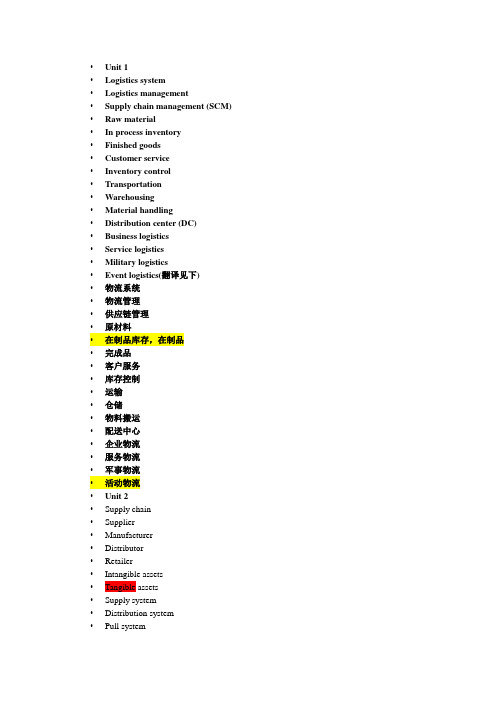
•Unit 1•Logistics system •Logistics management •Supply chain management (SCM) •Raw material•In process inventory •Finished goods •Customer service •Inventory control •Transportation •Warehousing•Material handling •Distribution center (DC) •Business logistics•Service logistics•Military logistics•Event logistics(翻译见下)•物流系统•物流管理•供应链管理•原材料•在制品库存,在制品•完成品•客户服务•库存控制•运输•仓储•物料搬运•配送中心•企业物流•服务物流•军事物流•活动物流•Unit 2•Supply chain•Supplier•Manufacturer•Distributor•Retailer•Intangible assets•Tangible assets•Supply system •Distribution system•Pull system•Push system•Pull-push system翻译见下•供应链•供应商•制造商•分销商•零售商•无形资产•有形资产•供应系统•分销系统•拉式系统•推式系统•推拉结合系统•Unit 3•product promotion •inventory management •warehouse operations •product transportation •customer support •after-sales service •product selection •transportation services •warehousing services •Financial service •make loans•credit analysis•due invoices翻译见下•产品促销•存货管理•仓库运营•产品运输•客户支持•售后服务•产品选择•运输服务•仓储服务•金融服务•提供贷款•信贷分析•到期发票•Unit3•客户满意•客户维系•交易营销•关系营销•常旅客计划•内部客户•外部客户•客户忠诚•前置时间•完美订单•服务细分(翻译见下)•Customer satisfaction•Customer retention•Transactional marketing•Relationship marketing•Frequent Flyer Program•Internal customer•External customer•Customer loyalty•Lead time•Perfect order•Service segment•Unit 4•indoor operation入库作业•warehouse management在库管理•warehouse operation出库操作•Replenishment补货•Order picking订单拣选•Order selection订单拣选•delivery note 提货单•Temporary storage (planned storage)计划性库存•Semi-permanent storage (extended storage)非计划性库存•Seasonal items配合季节性产品•Erratic demand items 需求变动大的产品•Product conditioning产品状态的控制•Speculative purchases推测性产品•Discount products折扣性产品•Public warehouse公共仓库•Private warehouse自用仓库•Contract warehouse契约仓库•general merchandise warehouse for manufactured goods普通仓库•refrigerated storage warehouse冷藏库•bonded warehouse保税仓库•special commodity warehouse特种商品仓库•bulk storage warehouse散装仓库•perishable items易腐烂产品•Customized (tailored) service定制服务•tank storage 灌储•unit 5•cycle (base) inventory 周期基本库存•safety (buffer) inventory 安全缓冲库存•in-transit( pipeline) inventory 在途供应线库存•speculative inventory 投机库存•dead stock 呆滞库存•average inventory平均库存•订货周期(order cycle time)•个案完成率(case fill rate)•产品线完成率(line fill rate)•订单供货率(order fill rate) •Opportunity cost机会成本•marginal cost 边际成本•Risk cost 风险成本•Fixed re-order inventory level定量订货法•Fixed time re-ordering 定期订货法•Economic order quantity 经济订货批量•Just in time production 准时制生产•Inventory turnover ratio库存周转率•Zero Inventory 零库存•Push system or Make-to-stock (MTS)推动式系统•Pull system or Make-to-order (MTO)拉动式系统•Hybrid system 混合系统•Dependent demand相关需求•Independent demand独立需求•VMI: Vendor-managed Inventory供应商管理库存•CRP: Continuous Replenishment持续补货•QR: Quick Response快速响应•ECR: Efficient Consumer Response有效客户反应•Unit 6•the consumer package消费者包装•the industrial package工业包装•集装袋(flexible container)•托盘(pallet)•集装箱(container)货柜•射频技术Radio Frequency Identification•运输标志(Shipping Mark)唛头•指示性标志(Indicative Mark)•警告性标志(Warning Mark)•Unit 7•Economy of scale规模经济•Economy of distance距离经济•Intermodal transportation 多式联运•Hybridsegment。
《物流实务英语》(英汉双语)

Summary 本章小结
The chapter focuses on the concept of supply chain and supply chain management. Supply chain consists of firms collaborating to serve the needs of end-customers. Supply chain consists of firms collaborating to take advantage of strategic position and to improve operating efficiency.
True or False 判断对错
1.There are a variety of definition about the term "logistics", each have slightly different meaning.
2. Logistics involves the flow and storage of "goods, services, and related information".
5. Good customer service is to make sure that the right person receive the right product with the right quantity at the right place at the right time in the right condition, even the cost is very high.
物流英语 Unit 3
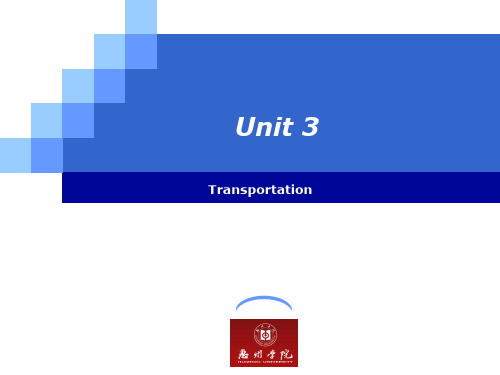
Transportation
ቤተ መጻሕፍቲ ባይዱ
Text 1 JIT
Jim is president of a medium-sized firm that makes minimotor homes in Michigan. The firm has expanded from a local Midwest market to a national one. As markets have expanded, so too have sources of supply for the company, with major suppliers located in Southern California, the Pacific Northwest, and Michigan. He decided to found the company here because the largest single component of the mini—the truck or van chassis upon which the rest of the vehicle is built—is purchased from one of the US light truck makers in Michigan. 吉姆是一个中型公司的总裁使微型家庭在密歇根州。该公司已从一个 国家当地中西部市场。随着市场的扩大,也为公司供应的来源,与主要 供应商位于南加州,太平洋西北地区,和密歇根州。他决定找到这里的 公司因为 mini-the 卡车或货车底盘的最大组成部分 , 其余的车辆建立 是购自美国轻型卡车制造商之一密歇根。
International transportation is an area of growing interest and concern to the logistician. The transportation equipment is the same as that used domestically, with the exception that certain elements of the transport system have become more important. For example, containerization is popular in international movement. The user of the international transportation system may feel over-whelmed by the increased documentation, by differences in carrier liability, by various customs procedures and the use of foreign trade zones. Fortunately, there exist middlemen, agents, freight forwarders, and brokers to assist the shipper with international movement. 国际运输是一个后勤人员日益增长的兴趣和关注的领域。运输设备是一样的, 在国内,除了某些元素的交通系统变得更加重要。例如,集装箱化在国际运动 很受欢迎。国际运输系统的用户可能会觉得over-whelmed增加文档,由承运 人责任的差异 ,不同的海关程序和对外贸易区域的使用。幸运的是,存在中间 商、代理商、货代,和经纪人协助托运人与国际运动。
物流专业英语UnitSupplychainconceptR
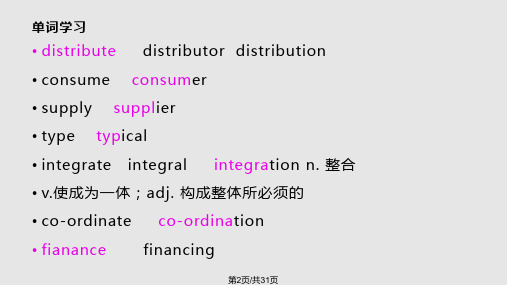
供应链从始至终的管理。
小问题: “如图1所示” 用英文怎么说?
第8页/共31页
What is supply chain management? Supply chain management (SCM) is concerned with
第21页/共31页
3. Put the following words or phrases into English:
1) 消除低下的效率 2) 产品的流转、贮存
和控制 3) 和供应相关的活动 4) 理想的服务水平
1) to eliminate inefficiency 2) movement, storage and
第4页/共31页
Text
The Supply Chain Concept 供应链概念
第5页/共31页
What is a supply chain?
A supply chain is a complex logistics system in which raw materials are converted into finished products and then distributed to end users (consumers or companies) (see Figure1). It includes suppliers, manufacturers, warehouses, distribution centres (DCs) and retail outlets.
第12页/共31页
The objectives of the SCM:
It is essential for the supply chain model to balance the costs (direct & indirect) of holding (or not) inventories against the need to serve endconsumers quickly and reliably.
